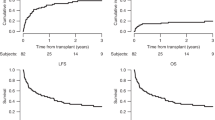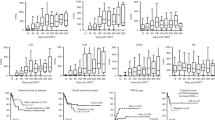Summary:
A 54-year-old RhD-negative male with del(20q)-positive myelodysplastic syndrome was transplanted with bone marrow from an HLA-identical RhD-positive sibling donor. Cytogenetic relapse was detected 21 months after stem cell transplantation (SCT), with reappearance of the original del(20q)-positive clone and reversion to recipient RhD-negative blood group. The patient received sequential donor lymphocyte infusions (DLIs), resulting in mild graft-versus-host disease and pure red cell aplasia. At 2 years post DLI, the patient remains in a stable condition, despite a dominance of recipient-derived erythro- and granulopoiesis originating in del(20q)-carrying progenitor cells. We conclude that reappearance of autologous erythropoiesis, upon relapse after allogeneic SCT, may be predictive of erythropenia after DLI and that re-emerging autologous del(20q)-positive erythropoiesis post DLI can provide a normal peripheral red blood cell count. Furthermore, in patients relapsing after blood-group-mismatched transplantation, a possible reversion to recipient blood group should be considered prior to blood transfusion or DLI.
This is a preview of subscription content, access via your institution
Access options
Subscribe to this journal
Receive 12 print issues and online access
$259.00 per year
only $21.58 per issue
Buy this article
- Purchase on Springer Link
- Instant access to full article PDF
Prices may be subject to local taxes which are calculated during checkout

Similar content being viewed by others
References
van Dijk BA, Drenthe-Schonk AM, Bloo A et al. Erythrocyte repopulation after allogeneic bone marrow transplantation. Analysis using erythrocyte antigens. Transplantation 1987; 44: 650–654.
Bär BMAM, Schattenberg A, van Dijk BA et al. Host and donor erythrocyte repopulation patterns after allogeneic bone marrow transplantation analysed with antibody-coated fluorescent microspheres. Br J Haematol 1989; 72: 239–245.
David B, Bernard D, Navenot JM et al. Flow cytometric monitoring of red blood cell chimerism after bone marrow transplantation. Transfus Med 1999; 9: 209–217.
Schaap N, Schattenberg A, Bär B et al. Red blood cell phenotyping is a sensitive technique for monitoring chronic myeloid leukaemia patients after T-cell-depleted bone marrow transplantation and after donor leucocyte infusion. Br J Haematol 2000; 108: 116–125.
Forsyth C, Nelson M, Popp H et al. Autologous red cell recovery and relapse of multiple myeloma after bone marrow transplantation: is this a graft-versus-myeloma effect? Bone Marrow Transplant 1996; 17: 457–459.
Schaap N, Schattenberg A, Mensink E et al. Long-term follow-up of persisting mixed chimerism after partially T cell-depleted allogeneic stem cell transplantation. Leukemia 2002; 16: 13–21.
Vardiman JW, Harris NL, Brunning RD et al. The World Health Organization (WHO) classification of the myeloid neoplasms. Blood 2002; 100: 2292–2302.
Greenberg P, Cox C, LeBeau MM et al. International scoring system for evaluating prognosis in myelodysplastic syndromes. Blood 1997; 89: 2079–2088.
Johansson B, Mertens F, Mitelman F . Primary vs secondary neoplasia-associated chromosomal abnormalities – balanced rearrangements vs genomic imbalances? Genes Chromosomes Cancer 1996; 16: 155–163.
Nilsson L, Åstrand-Grundström I, Anderson K et al. Involvement and functional impairment of the CD34+CD38−Thy-1+ hematopoietic stem cell pool in myelodysplastic syndromes with trisomy 8. Blood 2002; 100: 259–267.
Johansson B, Fioretos T, Mitelman F . Cytogenetic and molecular genetic evolution of Philadelphia-chromosome-positive chronic myeloid leukaemia. In: Bain BJ (ed.). Chronic Myeloproliferative Disorders. Karger: Basel, 2003, pp 44–61.
Redei I, Mangan KF, Ming PL et al. Detection of a dormant 20q- leukemia clone in bone marrow cultures with hematopoietic growth factors: implications for secondary leukemia post-transplant. Bone Marrow Transplant 1997; 19: 521–523.
Steensma DP, Dewald GW, Hodnefield JM et al. Clonal cytogenetic abnormalities in bone marrow specimens without clear morphologic evidence of dysplasia: a form fruste of myelodysplasia? Leuk Res 2003; 27: 235–242.
Acknowledgements
We thank Bodil Strömbeck (Department of Clinical Genetics in Lund) for her technical assistance in FISH analyses, as well as Anna Fossum and Dr Zhi Ma (Department of Stem Cell Biology in Lund) for their assistance in cell sorting. We also thank the Swedish Cancer Society, the Swedish Research Council, the Medical Faculty at Lund University and the Lund University Hospital Donation Funds for financial support of this study.
Author information
Authors and Affiliations
Corresponding author
Rights and permissions
About this article
Cite this article
Dykes, J., Lindmark, A., Lenhoff, S. et al. Autologous del(20q)-positive erythroid progenitor cells, re-emerging after DLI treatment of an MDS patient relapsing after allo-SCT, can provide a normal peripheral red blood cell count. Bone Marrow Transplant 33, 559–563 (2004). https://doi.org/10.1038/sj.bmt.1704383
Received:
Accepted:
Published:
Issue Date:
DOI: https://doi.org/10.1038/sj.bmt.1704383
Keywords
This article is cited by
-
Donor-derived isolated del(20q) after hematopoietic stem cell transplantation: report of two cases and review of the literature
Journal of Hematopathology (2013)



